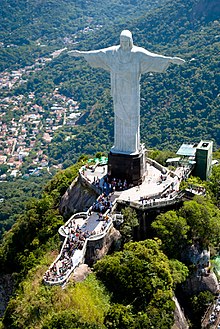
Ouro Preto, formerly Vila Rica, is a Brazilian municipality located in the state of Minas Gerais. The city, a former colonial mining town located in the Serra do Espinhaço mountains, was designated a World Heritage Site by UNESCO due to its Baroque colonial architecture. Ouro Preto used to be the capital of Minas Gerais from 1720 until the foundation of Belo Horizonte in 1897.

Antônio Francisco Lisboa, better known as Aleijadinho, was a sculptor, carver and architect of Colonial Brazil, noted for his works on and in various churches of Brazil. With a style related to Baroque and Rococo, Aleijadinho is considered almost by consensus as the greatest exponent of colonial art in Brazil by Brazilian critics and, surpassing Brazilian borders, for some foreign scholars he is the greatest name of Baroque in the Americas.

The Museu Nacional de Belas Artes is a national art museum located in the city of Rio de Janeiro, Brazil. The museum, officially established in 1937 by the initiative of education minister Gustavo Capanema, was inaugurated in 1938 by President Getúlio Vargas. The museum collection, on the other hand, takes its rise in the transfer of the Portuguese Court to Brazil in the early 19th century, when King John VI brought along with him part of the Portuguese Royal Collection. This art collection stayed in Brazil after the King's return to Europe and became the core collection of the National School of Fine Arts. When the museum was created in 1937, it became the heir not only the National School collection, but also of its headquarters, a 1908 eclectic style building projected by Spanish architect Adolfo Morales de los Ríos.

The creation of art in the geographic area now known as Brazil begins with the earliest records of its human habitation. The original inhabitants of the land, pre-Columbian Indigenous or Natives peoples, produced various forms of art; specific cultures like the Marajoara left sophisticated painted pottery. This area was colonized by Portugal in the 16th century and given the modern name of Brazil. Brazilian art is most commonly used as an umbrella term for art created in this region post Portuguese colonization.
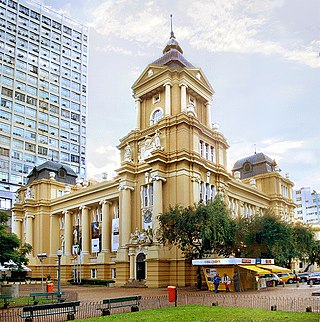
The Rio Grande do Sul Museum of Art is an art museum in the State of Rio Grande do Sul. It is located in the centre of Porto Alegre. Its eclectic building, national heritage, is one of the most noteworthy historic buildings in Porto Alegre. Its design is usually attributed to Theodor Wiederspahn, a German-Brazilian architect, although important local historian and artist Fernando Corona ascribes it to Germano Gundlach.

Gilded woodcarving in Portugal is, along with azulejos, one of the country's most original and rich artistic expressions. It is usually used in the interior decoration of churches and cathedrals and of noble halls in palaces and large public buildings. An impressive collection of altarpieces are found in Portuguese churches. Originating in the Gothic era, Portuguese gilded woodcarving assumed a nationalist character during the 17th century and reached its height in the reign of King D. João V. In the 19th century it lost its originality and began to disappear with the end of the revival era.

Rodolfo Amoedo was a Brazilian painter, designer and decorator.

The Baroque in Brazil was the dominant artistic style during most of the colonial period, finding an open ground for a rich flowering. It made its appearance in the country at the beginning of the 17th century, introduced by Catholic missionaries, especially Jesuits, who went there in order to catechize and acculturate the native indigenous peoples and assist the Portuguese in the colonizing process. In the course of the Colonial period, expressed a close association between the Church and the State, but in the colony there was not a court that would serve as a patron of the arts, the elites did not bother to build palaces, or to help sponsor the profane arts, but at the end of the period, and how the religion had a strong influence on the daily lives of everyone in this group of factors derives from the vast majority of the legacy of the Brazilian Baroque period, is the sacred art: statuary, painting, and the work of carving for the decoration of churches and convents, or for private worship.

The Pinacoteca do Estado de São Paulo is one of the most important art museums in Brazil. It is housed in a 1900 building in Jardim da Luz, Downtown São Paulo, designed by Ramos de Azevedo and Domiziano Rossi to be the headquarters of the Lyceum of Arts and Crafts. It is the oldest art museum in São Paulo, founded on December 24, 1905, and established as a public state museum since 1911.
The Artistic-Cultural Collection of the Governmental Palaces of the State of São Paulo, Brazil, aims to document, preserve and divulge circa 3,500 works of art of great artistic and cultural significance, which belong to the state's heritage. These works of art are located in the historical buildings of the Palácio dos Bandeirantes, the Palácio do Horto, in the city of São Paulo, and the Palácio Boa Vista, in Campos do Jordão.

The Ema Gordon Klabin Cultural Foundation is an art museum located in the city of São Paulo, Brazil. Officially established in 1978, it is a not-for-profit private institution, legally declared as an organization of federal public interest. It was created by the Brazilian collector and philanthropist Ema Gordon Klabin (1907–1994), with the purpose of preserving and displaying her art collection, as well as promoting cultural, artistic and scientific activities. The foundation is headquartered in Ema's former house in Jardins district, specially designed by architect Alfredo Ernesto Becker in the 1950s to hold her collection. The house is surrounded by a 4,000 square meters garden projected by Brazilian landscape architect Roberto Burle Marx.

The Imperial Academy of Fine Arts was an institution of higher learning in the arts in Rio de Janeiro, Brazil, established by King João VI. Despite facing many initial difficulties, the Academy was established and took its place at the forefront of Brazilian arts education in the second half of the nineteenth century. The Academy became the center of the diffusion of new aesthetic trends and the teaching of modern artistic techniques. It eventually became one of the principal arts institutions under the patronage of Emperor Dom Pedro II. With the Proclamation of the Republic, it became known as the National School of Fine Arts. It became extinct as an independent institution in 1931, when it was absorbed by the Federal University of Rio de Janeiro (UFRJ) and became known as the UFRJ School of Fine Arts, which still operates today.
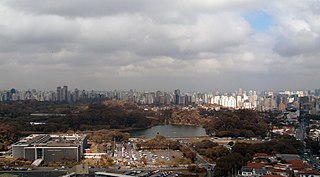
Museum of Art of the Parliament of São Paulo is a contemporary art museum housed in the Palácio 9 de Julho, the Legislative Assembly of São Paulo house. The Palace is located in south of the city, opposite to the Ibirapuera Park.

The Museum of Sacred Art of São Paulo a museum dedicated to the collection and display of sacred art of Brazil. It is located in the Luz neighborhood of São Paulo in the left wing of the Luz Monastery, a religious institution founded in 1774 by Frei Galvão. The monastery is the only colonial building of the eighteenth century in São Paulo to preserve its original building elements, materials and structure. The monastery was listed as an architectural monument of national importance in 1943 by the National Institute of Historic and Artistic Heritage (IPHAN) and subsequently by the State of São Paulo Council for the Defense of the Historical, Archaeological, Artistic and Touristic Heritage (CONDEPHAAT).
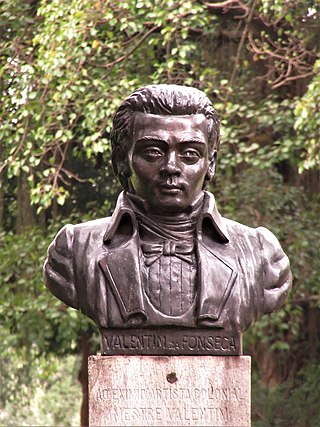
Valentim da Fonseca e Silva, better known as Mestre Valentim, was a Brazilian sculptor and urban planner. Like Antonio Francisco Lisboa, also known as Aleijadinho, he is one of the most famous artists of colonial Brazil and was of mixed race. Mestre Valentim recounts details of his life in his testament. He was born in Serro do Frio to Manoel da Fonseca e Silva, a white man, and Amatilde da Fonseca, a black woman. Although he never married, his relationship with Josefa Maria da Conceição resulted in a daughter named Joana. Although the details of his artistic training are up to debate, he may have traveled to Portugal with his family as a child. By adulthood, he found himself living and working in Rio de Janeiro.
Dudi Maia Rosa is a Brazilian artist.
Classical music in Porto Alegre, the capital of Rio Grande do Sul, Brazil, begins at the end of the 18th century, but this artistic field did not really begin to flourish until the middle of the 19th century, and was consolidated throughout the 20th century with the founding of several educational institutions and the proliferation of groups, interpreters and composers, projecting the city across the state as the main producer and radiator of influence. Currently Porto Alegre has a considerable audience for classical music; it is in the script of concertists of international fame, has two stable orchestras and a chamber orchestra, and numerous smaller chamber groups and vocal and instrumental soloists, as well as a large number of music schools and performance spaces. Some of its composers have known national fame. According to conductor Isaac Karabtchevsky, who was the artistic director of OSPA, "there is no greater identity in music in the world than in the population of Porto Alegre". At the same time there is a significant development in academic research and advanced professional qualification in undergraduate and graduate courses in music at UFRGS.

Brazilian Romantic painting was the leading artistic expression in Brazil during the latter half of the 19th century, coinciding with the Second Reign. It represented a unique evolution of the Romantic movement; it diverged significantly from its European counterpart and even the parallel Romantic movement in Brazilian literature. Characterized by a palatial and restrained aesthetic, it incorporated a strong neoclassical influence and gradually integrated elements of Realism, Symbolism, and other schools, resulting in an eclectic synthesis that dominated the Brazilian art scene until the early 20th century.

—
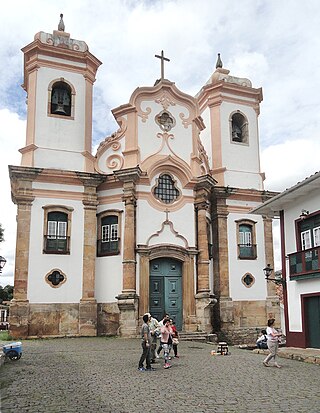
The Minor Basilica of Our Lady of the Pillar in Ouro Preto, Minas Gerais, popularly called the Our Lady of the Pillar Mother Church, is one of the best known Catholic buildings among those erected during the Brazilian Gold Rush. It is a listed monument by the National Historic and Artistic Heritage Institute (IPHAN). It is located at the Monsenhor Castilho Barbosa Square.


